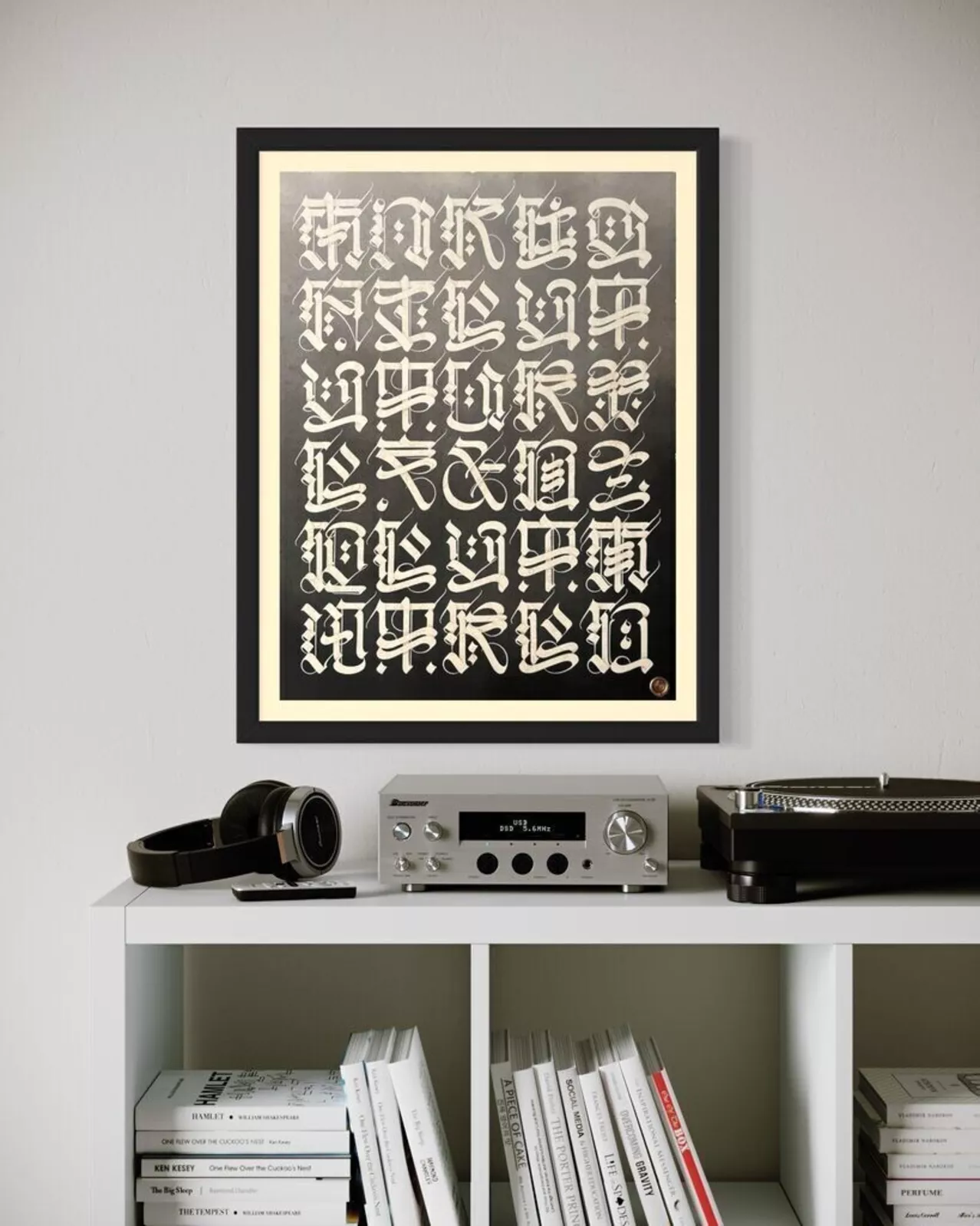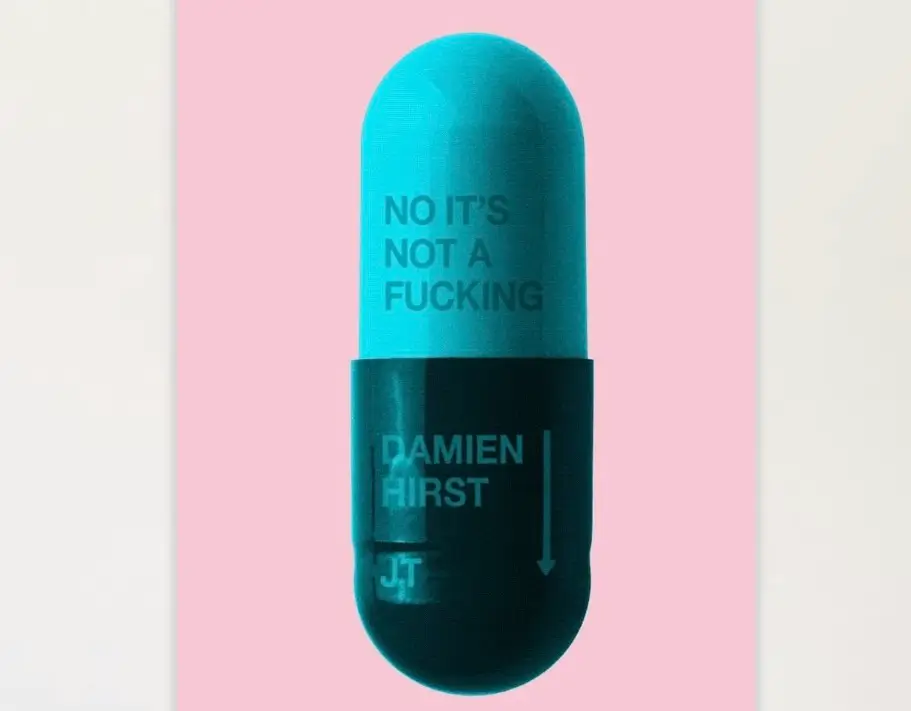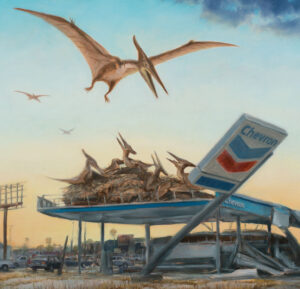The painting opens not with the city, but with a table—an everyday surface transformed into a stage of quiet significance. The yellow-and-white checkered pattern is warm, sunlit, and unmistakably intentional. It is the kind of patterned geometry that brings rhythm into a space before a single object is placed upon it. On top of this grid sits a small collection of familiar things: a bowl of fruit resting atop layered cloth, a small ceramic vessel, a blue teapot, a handful of tiny items that feel collected rather than curated, and a vase of deep blue irises whose blossoms offer the most concentrated color in the entire work.
These objects are not extravagant; they are humble. Their arrangement feels natural, the sort of composition that happens not through staging but through the lived rhythm of a morning. In this way, the table becomes the emotional anchor of the painting. It is where the viewer enters the scene, where the story begins, where the human presence can be felt even in the absence of a person. In the irises, especially, the painting communicates a sense of care. Someone placed them there. Someone recognized the beauty they might bring to the day. They rise above the tabletop with a quiet dignity, offering a counterpoint to the ordered world beyond.
The still life is not simply a foreground element; it is the lens through which everything else is seen.
choreography
Beyond the table, the city opens up in a sweeping, horizontal panorama. Buildings shrink into pastel blocks; streets slice the space into straight, uninterrupted lines; the landscape unfolds with a calmness rarely granted to Los Angeles in photography or film. This is an LA freed from the weight of noise and motion. The sprawl becomes a soft geometry, something contemplative rather than overwhelming.
From this elevated vantage point—perhaps a hillside home or an apartment terrace—the city feels almost dreamlike. The shifts in color are gentle. The architecture is softened. Nothing intrudes or competes. The artist renders Brentwood not in precise realism, but in an idealized clarity that echoes the careful arrangement of the tabletop. Distance becomes a form of order. The chaos of urban life dissolves into a harmonious grid.
There is a lineage here, whether deliberate or subconscious. Wayne Thiebaud’s pastel cities, David Hockney’s open horizons, and Jonas Wood’s flattening of interior and exterior all whisper through the canvas. Yet this painting has its own voice, its own lightness. It uses these influences not as templates but as atmospheric touchpoints. The city is not a spectacle but a setting, a distant hum that frames the quiet intimacy of the foreground.
relation
One of the most compelling aspects of this painting is the dialogue between the immediate and the distant. The table is close, tactile, warm. The city is far, abstracted, cool. Yet the artist does not treat them as opposites. Instead, they mirror each other through structure and rhythm.
The checkered tabletop echoes the city grid below. The small objects on the table correspond to the varied rooftops and building shapes in the landscape. The arrangement of colors—vivid in the foreground, muted in the distance—creates a subtle bridge between interior calm and exterior scale. The painting suggests that the domestic and the metropolitan are not competing forces but interconnected layers of the same experience.
This duality reflects the lived reality of Los Angeles, a city where private space and public vista often meet in a single glance. Anyone who has lived in the hills or the elevated apartments of Brentwood knows the feeling: a cup of coffee resting on a table while miles of city shimmer beyond the balcony. That simultaneity—of stillness and sprawl—becomes the emotional center of the painting.
The artist captures this not through dramatic lighting or grand gesture, but through quiet balance.
theme
The color palette is unmistakably Californian. Soft blues stretch across the sky in horizontal bands, creating a sense of atmosphere and ease. The city below is rendered in cool greens, gentle pinks, and pale neutrals, allowing the eye to drift comfortably across the landscape. It is a palette that avoids the clichés of Los Angeles’ neon culture and instead embraces the softer tones of morning light.
In the foreground, color becomes more concentrated. The warm yellows of the table, the deep blues of the irises, the quiet reds and oranges of the fruit—all of these hues create emotional anchoring. The foreground is where the viewer feels, while the background is where the viewer breathes. This intentional contrast in temperature gives the painting depth without relying on heavy shadows or dramatic perspective.
The artist’s restraint is particularly powerful. Rather than using bold contrasts or intense pigments, they allow softness to carry the scene. The result is a painting that feels both expansive and intimate, airy yet grounded.
idea
What truly stands out is how the painting reimagines Los Angeles. This is not the LA of cinema, nor the LA of freeways and rehearsed glamour. It is not a city defined by its complications. Instead, it is the LA experienced from home—a city seen through the patterns of daily life, through morning rituals, through quiet observation.
The artwork reflects a contemporary sensibility in which domestic space has become central to understanding the outside world. In the past decade, as people have spent more time looking out from their windows, balconies, and kitchen tables, this dual perspective has grown more culturally significant. The painting captures that shift. It understands that cities are no longer places we simply move through; they are landscapes we contemplate from within our private spaces.
Brentwood, in this context, becomes both a real neighborhood and a symbol of a certain kind of Los Angeles calm—ordered, bright, expansive, and gently reflective.
flow
This painting offers a version of Los Angeles that feels deeply human. It understands the city as something that unfolds slowly from the vantage point of a single room. The table is not merely décor; it is a companion to the cityscape. The city is not merely background; it is the distance against which intimacy takes shape.
In bringing these two worlds together, the artist creates a portrait of quiet modern living—one where the rituals of home and the enormity of the metropolis coexist in a single, harmonious breath. The painting’s beauty lies not in spectacle but in stillness. It invites the viewer to pause, to look closely, and to feel the subtle balance between presence and horizon.
No comments yet.








